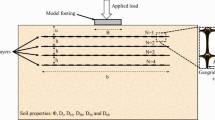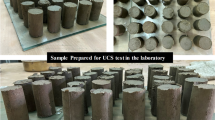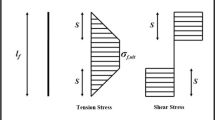Abstract
Fiber-reinforced soil (FRS) has been used as a promising alternative material for civil and construction engineering. Shear strength of FRS is influenced complexly by many factors including fiber properties, soil properties, and stress conditions. This inherent complexity limits the ability of designers to assess shear strength parameters and has made it difficult to establish a mathematical model for accurately predicting the FRS shear strength. Accurately estimating the shear strength of FRS is vital for civil engineers in designing geotechnical structures and management. Thus, this work proposed a novel computational method, namely a swarm intelligence optimized regression (SIOR) system to estimate the peak shear strength of randomly distributed FRS. The SIOR system integrates a machine learning technique with an enhanced swarm intelligence algorithm to obtain reliable and good performance in prediction process. The real-world FRS dataset collected over the past 30 years was used to validate the proposed system. To demonstrate the capability of the proposed system, the SIOR modeling results were compared with those obtained using numeric predictive models. The analytical results confirm that the SIOR system is superior to a baseline machine learning model and empirical methods via cross-fold validation and hypothesis test with accuracy improvement from 44.7 to 99.7% in mean absolute percentage error. Therefore, the SIOR system can significantly improve the prediction accuracy and facilitate civil engineers in estimating the shear strength of the FRS.







Similar content being viewed by others
References
Li C, Zornberg J (2013) Mobilization of reinforcement forces in fiber-reinforced soil. J Geotech Geoenviron Eng 139(1):107–115. doi:10.1061/(ASCE)GT.1943-5606.0000745
Ranjan G, Vasan RM, Charan HD (1996) Probabilistic analysis of randomly distributed fiber-reinforced soil. J Geotech Eng 122(6):419–426. doi:10.1061/(ASCE)0733-9410(1996)122:6(419)
Zornberg JG (2002) Discrete framework for limit equilibrium analysis of fibre-reinforced soil. Géotechnique 52:593–604
Michalowski R, Čermák J (2003) Triaxial compression of sand reinforced with fibers. J Geotech Geoenviron Eng 129(2):125–136. doi:10.1061/(ASCE)1090-0241(2003)129:2(125)
Najjar S, Sadek S, Alcovero A (2013) Quantification of model uncertainty in shear strength predictions for fiber-reinforced sand. J Geotech Geoenviron Eng 139(1):116–133. doi:10.1061/(ASCE)GT.1943-5606.0000742
Chou J-S, Cheng M-Y, Wu Y-W (2013) Improving classification accuracy of project dispute resolution using hybrid artificial intelligence and support vector machine models. Expert Syst Appl 40(6):2263–2274. doi:10.1016/j.eswa.2012.10.036
X-h T, W-h B, X-l H, Wang W (2011) Reliability analysis using radial basis function networks and support vector machines. Comput Geotech 38(2):178–186. doi:10.1016/j.compgeo.2010.11.002
Chou J-S, Lin C (2013) Predicting disputes in public-private partnership projects: classification and ensemble models. J Comput Civ Eng 27(1):51–60. doi:10.1061/(ASCE)CP.1943-5487.0000197
Chou J-S, Pham A-D (2013) Enhanced artificial intelligence for ensemble approach to predicting high performance concrete compressive strength. Constr Build Mater 49:554–563. doi:10.1016/j.conbuildmat.2013.08.078
Wei X-K, Li Y-H, Li Y-F, Zhang D-F (2008) Enclosing machine learning: concepts and algorithms. Neural Comput Appl 17(3):237–243
Cao MS, Pan LX, Gao YF, Novák D, Ding ZC, Lehký D, Li XL (2015) Neural network ensemble-based parameter sensitivity analysis in civil engineering systems. Neural Comput Appl. doi:10.1007/s00521-015-2132-4
Suykens JAK, Gestel TV, Brabanter JD, Moor BD, Vandewalle J (2002) Least squares support vector machines. World Scientific, Singapore
Zhang H, Yang F, Li Y, Li H (2015) Predicting profitability of listed construction companies based on principal component analysis and support vector machine—evidence from China. Autom Constr 53:22–28. doi:10.1016/j.autcon.2015.03.001
Chou J-S, Chong WK, Bui D-K (2016) Nature-inspired metaheuristic regression system: programming and implementation for civil engineering applications. J Comput Civ Eng 30(5):04016007. doi:10.1061/(ASCE)CP.1943-5487.0000561
Chou J-S, Ngo N-T (2016) Time series analytics using sliding window metaheuristic optimization-based machine learning system for identifying building energy consumption patterns. Appl Energy 177:751–770. doi:10.1016/j.apenergy.2016.05.074
Pal M, Deswal S (2011) Support vector regression based shear strength modelling of deep beams. Comput Struct 89(13–14):1430–1439. doi:10.1016/j.compstruc.2011.03.005
Martins FF, Begonha A, Amália Sequeira Braga M (2012) Prediction of the mechanical behavior of the Oporto granite using data mining techniques. Expert Syst Appl 39(10):8778–8783. doi:10.1016/j.eswa.2012.02.003
Chou J-S, Ngo N-T, Chong WK (2016) The use of artificial intelligence combiners for modeling steel pitting risk and corrosion rate. Eng Appl Artif Intell. doi:10.1016/j.engappai.2016.09.008
Yang X-S (2014) Analysis of algorithms. In: Nature-inspired optimization algorithms. Elsevier, Oxford, pp 23–44. doi:10.1016/B978-0-12-416743-8.00002-6
Roque CMC, Martins PALS (2015) Differential evolution for optimization of functionally graded beams. Compos Struct 133:1191–1197. doi:10.1016/j.compstruct.2015.08.041
Yang X-S (2014) Firefly algorithms. In: Yang X-S (ed) Nature-inspired optimization algorithms. Elsevier, Oxford, pp 111–127. doi:10.1016/B978-0-12-416743-8.00008-7
Chou J-S, Ngo N-T, Pham A-D (2016) Shear strength prediction in reinforced concrete deep beams using nature-inspired metaheuristic support vector regression. J Comput Civ Eng 30(1):04015002. doi:10.1061/(ASCE)CP.1943-5487.0000466
Ibraim E, Fourmont S (2007) Behaviour of sand reinforced with fibres. Soil Stress Strain Behav Meas Model Anal 146:807–818. doi:10.1007/978-1-4020-6146-2_60
Hejazi SM, Sheikhzadeh M, Abtahi SM, Zadhoush A (2012) A simple review of soil reinforcement by using natural and synthetic fibers. Constr Build Mater 30:100–116. doi:10.1016/j.conbuildmat.2011.11.045
Consoli N, Prietto P, Ulbrich L (1998) Influence of fiber and cement addition on behavior of sandy soil. J Geotech Geoenviron Eng 124(12):1211–1214. doi:10.1061/(ASCE)1090-0241(1998)124:12(1211)
Ahmad F, Bateni F, Azmi M (2010) Performance evaluation of silty sand reinforced with fibres. Geotext Geomembr 28(1):93–99. doi:10.1016/j.geotexmem.2009.09.017
Sivakumar Babu GL, Vasudevan AK, Haldar S (2008) Numerical simulation of fiber-reinforced sand behavior. Geotext Geomembr 26(2):181–188. doi:10.1016/j.geotexmem.2007.06.004
Chauhan MS, Mittal S, Mohanty B (2008) Performance evaluation of silty sand subgrade reinforced with fly ash and fibre. Geotext Geomembr 26(5):429–435. doi:10.1016/j.geotexmem.2008.02.001
Gray DH, Ohashi H (1983) Mechanics of fiber reinforcement in sand. J Geotech Eng 109(3):335–353. doi:10.1061/(ASCE)0733-9410(1983)109:3(335)
Maher M, Gray D (1990) Static response of sands reinforced with randomly distributed fibers. J Geotech Eng 116(11):1661–1677. doi:10.1061/(ASCE)0733-9410(1990)116:11(1661)
Cruz M, Santos JM, Cruz N (2015) Using neural networks and support vector regression to relate Marchetti dilatometer test parameters and maximum shear modulus. Appl Intell 42(1):135–146
Sadek S, Najjar S, Freiha F (2010) Shear strength of fiber-reinforced sands. J Geotech Geoenviron Eng 136(3):490–499. doi:10.1061/(ASCE)GT.1943-5606.0000235
Al-Refeai TO (1991) Behavior of granular soils reinforced with discrete randomly oriented inclusions. Geotext Geomembr 10(4):319–333. doi:10.1016/0266-1144(91)90009-L
Michalowski R, Zhao A (1996) Failure of fiber-reinforced granular soils. J Geotech Eng 122(3):226–234. doi:10.1061/(ASCE)0733-9410(1996)122:3(226)
Wang H, Hu D (2005) Comparison of SVM and LS-SVM for regression. In: International conference on neural networks and brain, 2005. ICNN&B ‘05, pp 279–283. doi:10.1109/ICNNB.2005.1614615
Tang D, Dong S, Cai X, Zhao J (2015) A two-stage quantum-behaved particle swarm optimization with skipping search rule and weight to solve continuous optimization problem. Neural Comput Appl. doi:10.1007/s00521-015-2014-9
Altun A, Şahman M (2013) Cost optimization of mixed feeds with the particle swarm optimization method. Neural Comput Appl 22(2):383–390. doi:10.1007/s00521-011-0701-8
Yang X-S (2008) Firefly algorithm. Nature-inspired metaheuristic algorithms. Luniver Press, Bristol
Fister I, Fister I Jr, Yang X-S, Brest J (2013) A comprehensive review of firefly algorithms. Swarm Evol Comput 13:34–46. doi:10.1016/j.swevo.2013.06.001
Liu B, Wang L, Jin Y-H, Tang F, Huang D-X (2005) Improved particle swarm optimization combined with chaos. Chaos Solitons Fractals 25(5):1261–1271. doi:10.1016/j.chaos.2004.11.095
He D, He C, Jiang LG, Zhu HW, Hu GR (2001) Chaotic characteristics of a one-dimensional iterative map with infinite collapses. IEEE Trans Circuits Syst I Fundam Theory Appl 48(7):900–906
Geisel T, Nierwetberg J, Zacherl A (1985) Accelerated diffusion in Josephson junctions and related chaotic systems. Phys Rev Lett 54(7):616–619
Pavlyukevich I (2007) Cooling down Lévy flights. J Phys A Math Theor 40(41):12299. doi:10.1088/1751-8113/40/41/003
Kohavi R (1995) A study of cross-validation and bootstrap for accuracy estimation and model selection. In: The international joint conference on artificial intelligence, pp 1137–1143
Gray D, Al-Refeai T (1986) Behavior of fabric-versus fiber-reinforced sand. J Geotech Eng 112(8):804–820. doi:10.1061/(ASCE)0733-9410(1986)112:8(804)
Shao W, Cetin B, Li Y, Li J, Li L (2014) Experimental investigation of mechanical properties of sands reinforced with discrete randomly distributed fiber. Geotech Geol Eng 32(4):901–910. doi:10.1007/s10706-014-9766-3
Ibraim E, Fourmont S (2007) Behaviour of sand reinforced with fibres. In: Ling H, Callisto L, Leshchinsky D, Koseki J (eds) Soil stress–strain behavior: measurement, modeling and analysis, vol 146., Solid mechanics and its applicationsSpringer, Berlin, pp 807–818. doi:10.1007/978-1-4020-6146-2_60
Yetimoglu T, Salbas O (2003) A study on shear strength of sands reinforced with randomly distributed discrete fibers. Geotext Geomembr 21(2):103–110. doi:10.1016/S0266-1144(03)00003-7
Consoli NC, Casagrande MDT, Coop MR (2007) Performance of a fibre-reinforced sand at large shear strains. Géotechnique 57:751–756
Consoli NC, Festugato L, Heineck KS (2009) Strain-hardening behaviour of fibre-reinforced sand in view of filament geometry. Geosynth Int 16:109–115
Nataraj MS, McManis KL (1997) Strength and deformation properties of soils reinforced with fibrillated fibers. Geosynth Int 4:65–79
Consoli NC, Montardo JP, Donato M, Prietto PD (2004) Effect of material properties on the behaviour of sand—cement—fibre composites. Proc ICE Ground Improv 8:77–90
Chen C-W (2007) A constitutive model for fiber-reinforced soils. University of Missouri, Columbia
Gregory GH (2006) Shear strength, creep and stability of fiber-reinforced soil slopes. Oklahoma State University, Stillwater
Al-Refeai T, Al-Suhaibani A (1998) Dynamic and static characterization of polypropylene fiber-reinforced dune sand. Geosynth Int 5(5):443–458
Author information
Authors and Affiliations
Corresponding author
Rights and permissions
About this article
Cite this article
Chou, JS., Ngo, NT. Engineering strength of fiber-reinforced soil estimated by swarm intelligence optimized regression system. Neural Comput & Applic 30, 2129–2144 (2018). https://doi.org/10.1007/s00521-016-2739-0
Received:
Accepted:
Published:
Issue Date:
DOI: https://doi.org/10.1007/s00521-016-2739-0




